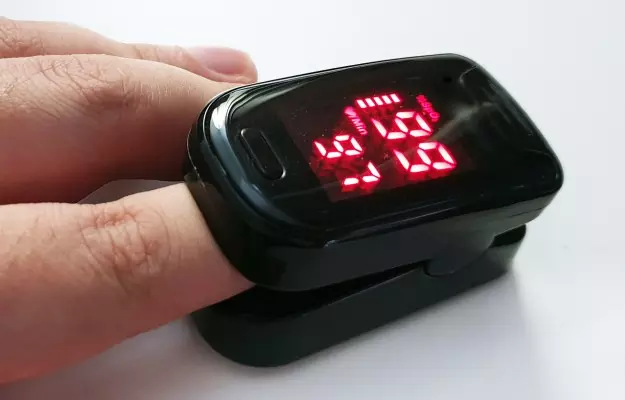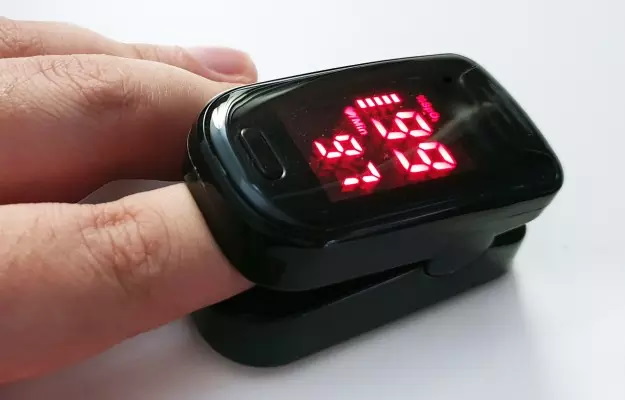Pulse oximeter is a simple device that uses infrared light to measure the amount of oxygen in your blood—it takes just seconds to do this.
More commonly used in hospitals, a pulse oximeter is simple enough to use at home—all you need to do is put the machine (it looks a bit like a stapler) on your index finger or big toe or ear lobe—whichever is convenient—and turn it on. It gives a reading in SpO2 which is the percentage of oxygen saturation in the blood. A reading below 95% means you should call your doctor.
Of late, many people have started buying pulse oximeters and with good reason. The COVID-19 outbreak has become associated with what is colloquially known as happy hypoxia or silent hypoxia. Simply put, happy hypoxia is a condition in which the patient does not exhibit any outward signs of low oxygen saturation until the blood oxygen levels drop significantly, at which point the patient may need emergency care. Having a pulse oximeter to periodically check blood oxygen levels could alert people if their oxygen levels start falling.
Conversely, getting a normal reading could also give them some peace of mind that they are not in any immediate danger. (That said, keep in mind that shortness of breath and hypoxia are severe symptoms of COVID-19. Milder symptoms of COVID-19 like fever, cough, fatigue and loss of sense of smell or taste should not be ignored, even if your oxygen saturation levels are okay.)
Read on to know all about pulse oximeters, including how they work and who needs them.
Read more: How to deal with the anxiety of living through a pandemic
- What is a pulse oximeter?
- How does the pulse oximeter work?
- Advantages of a pulse oximeter
- Is a pulse oximeter useful during COVID-19?
- Takeaway
What is a pulse oximeter?
Pulse oximeters are medical devices that calculate or monitor the level of oxygen in a patient's bloodstream, to alert a doctor or healthcare worker of the status of their physical health.
The test done while using this device is known as pulse oximetry, where the device is clipped onto the finger of a person and it reads their heart rate as well as the oxygen saturation level in their red blood cells. Patients or people with chronic respiratory problems have often been seen using these small devices.
A reading of 95-100% on the pulse oximeter is considered to be normal for an average person, and any value below 90% is considered to be low, as it counts how well oxygen is reaching the hands and feet, the parts of the body far away from the heart that pumps blood to them. If the reading does indeed drop to below that figure, supplemental oxygen could be used to supply adequate oxygen to the patient’s bloodstream.
Medical experts have been using pulse oximeters to assess a patient’s blood oxygen levels in emergency situations, operations or even critical care, and they are routinely used by pulmonologists as well.
Such has been the demand for these devices during the COVID-19 crisis that they have flown off the shelves of medical stores around the world, once it became known that low oxygen saturation levels in a person's bloodstream could be a sign of serious illness caused by the SARS-CoV-2 coronavirus.
How does the pulse oximeter work?
The pulse oximeter sends infrared light to the capillaries (the tiniest blood vessels) in the finger/toe/ear lobe and measures the light reflected back by the oxygen, to get an idea of oxygen saturation within seconds. The machine also monitors pulse rate.
(Pulse oximeters are also available for foreheads and noses—research shows that the readings for super-low oxygen [about 80%] saturation may be captured by the ear or nose much faster than the finger or toe though the finger and toe seem to give more accurate readings.)
A reading between 95% and 100% is absolutely normal. For a person with chronic respiratory illness, the normal range may be a bit lower—if you have chronic lung disease, check with your doctor to know the safe oxygen saturation range for you.
Pulse oximeters do have a few limitations, though: first, they have a margin of error of about 2%. And second, it may not work if you are wearing nail paint or if your extremities (hands and feet) tend to be very cold.
In most other cases, the pulse oximeter is an easy-to-use and reliable machine to measure oxygen saturation in the blood. A pulse oximeter can cost anywhere from Rs 500 to 5,000, depending on the brand. Some may even have features like Bluetooth connectivity to your phone, to record the readings automatically. If you are using a pulse oximeter that doesn't automatically keep a record of the readings, it is a good idea to make a note of these in a notebook or online where you can pull the readings up for your doctor to see, if necessary.
Advantages of a pulse oximeter
Let's take a step back to see why and when we need to measure blood oxygen saturation: the haemoglobin in our red blood cells binds with oxygen to take it to different parts of the body. According to the "WHO pulse oximetry training manual 2011", each haemoglobin molecule can carry up to four molecules of oxygen. If every haemoglobin molecule in the body binds with four oxygen molecules each, blood oxygen saturation is 100%. Normally, the oxygen saturation or SpO2 in haemoglobin is 95% or more.
In medical conditions that cause shortness of breath or chest pain and respiratory illnesses like asthma, chronic obstructive pulmonary disease and now COVID-19, however, blood oxygen saturation may drop to or below 94%—this state of low blood oxygen is known as hypoxemia. Patients with hypoxemia need supportive oxygen therapy, which could be given through simple but effective equipment like an oxygen cylinder and cannula/mask, or an oxygen concentrator (which uses oxygen from the air around us and doesn't even require an oxygen cylinder). If unchecked, hypoxemia can advance to a stage where the different organs of the body don't get enough oxygen for normal processes—this condition is known as hypoxia. This is a potentially life-threatening condition in which the patient will definitely need oxygen therapy, and may even need heavy-duty oxygen support through a ventilator or ECMO (extracorporeal membrane oxygenation) machine in a hospital. (The ECMO machine oxygenates the blood outside the body, hence the term extracorporeal.)
A pulse oximeter can quickly alert doctors, caregivers or patients to dangerously low oxygen saturation in the blood or hypoxemia—sometimes even before symptoms like difficulty breathing and cyanosis show up. This can help save precious minutes in getting the necessary therapy to treat hypoxemia and prevent hypoxia. (Cyanosis, or lips and fingers/toes turning blue, may occur in some patients with blood oxygen saturation below 90%. However, doctors warn, cyanosis is quite hard to spot and may not even occur in patients who have anaemia).
Is a pulse oximeter useful during COVID-19?
On 24 April, Union Health Minister Dr Harsh Vardhan said the use of a pulse oximeter could help in the early detection and diagnosis of COVID-19 patients, which could in turn help control the fatalities caused by the pneumonia-like disease.
Breathlessness has been described as a severe symptom in patients of COVID-19, and those who indeed develop such signs can definitely make good use of the pulse oximeter. But the disease has been known to show several different symptoms in the body in the form of fever, dry cough and tiredness, which have been identified as some of the mild symptoms of the disease.
Some of the less common symptoms also include body ache, sore throat, diarrhoea, conjunctivitis and headaches, besides a loss of smell and taste as well as skin rashes. That shortness of breath as a symptom does not develop until the disease worsens makes it difficult for a person to be able to self-diagnose.
According to Yale Medicine, some doctors have also reported that COVID-19 patients suddenly develop a condition known as silent hypoxia, where patients may feel uncomfortable but do not report any shortness of breath even though their oxygen levels may have fallen dramatically low.
Although such symptoms have been reported in patients at home as well as ones admitted in a hospital, such a problem only develops when the patient has begun showing severe symptoms of the infection and requires ventilator support. (Read more: Risks of intubation and ventilator use for COVID-19 patients)
Monitoring your own oxygen saturation levels at home, therefore, becomes a natural response to a public health crisis like this.
Takeaway
The haemoglobin in our blood carries oxygen to the entire body. One gram of haemoglobin typically combines with around 1.34 ml of oxygen. This means that someone with haemoglobin of 15g/dL would have about 20 ml of oxygen in every 100 ml of blood.
Under normal circumstances, the use of a pulse oximeter can be recommended to patients with chronic lung diseases such as COPD, asthma, pneumonia, lung cancer or certain heart diseases as well. It also helps medical practitioners to assess if the medications prescribed for any of the above-mentioned conditions are working as they were intended to, or evaluate other parameters such as how beneficial the use of a ventilator has been for a patient.
Patients with any of the symptoms such as cough, fever or breathlessness that have been causing discomfort may use a pulse oximeter to do a reading of their oxygen saturation levels, as it can give an indication to a person whether they should visit the hospital.
The use of a pulse oximeter can also be helpful for people living with comorbidities such as high blood pressure, diabetes or any kind of heart disease. However, it is also equally important to use the device properly, as an improperly placed pulse oximeter on the finger or toe of a person or an oximeter placed on painted nails could give a false reading.
Doctors for Pulse Oximeter

Dr Rahul Gam
Infectious Disease
8 Years of Experience

Dr. Arun R
Infectious Disease
5 Years of Experience

Dr. Neha Gupta
Infectious Disease
16 Years of Experience

Dr. Anupama Kumar
Infectious Disease
References
- Johns Hopkins Medicine [Internet]. The Johns Hopkins University, The Johns Hopkins Hospital, and Johns Hopkins Health System; Pulse Oximetry
- Yale School of Medicine. [Internet] New Haven, CT, USA. Should You Really Have a Pulse Oximeter at Home?
- World Health Organization [Internet]. Geneva (SUI): World Health Organization; Pulse oximetry.
- Volkov VY et al. Enhancing the reliability and accuracy of pulse oximetry with a built-in expert system. Biomedical Engineering. 1993 May; 27: 133-138.
- Wilkerson RG et al. Silent hypoxia: A harbinger of clinical deterioration in patients with COVID-19. American Journal of Emergency Medicine. 2020 May [Internet]. PMID: 32471783.
- World Health Organization, Geneva [Internet]. Pulse oximetry training manual.











